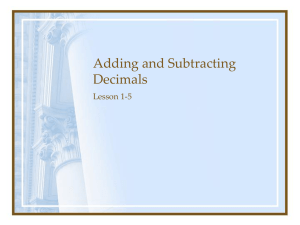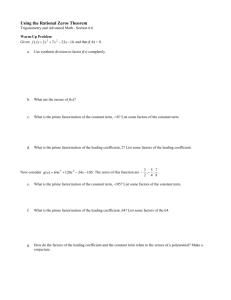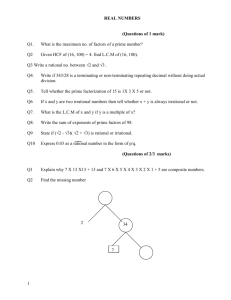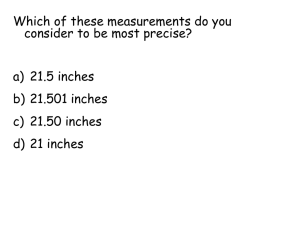File
advertisement
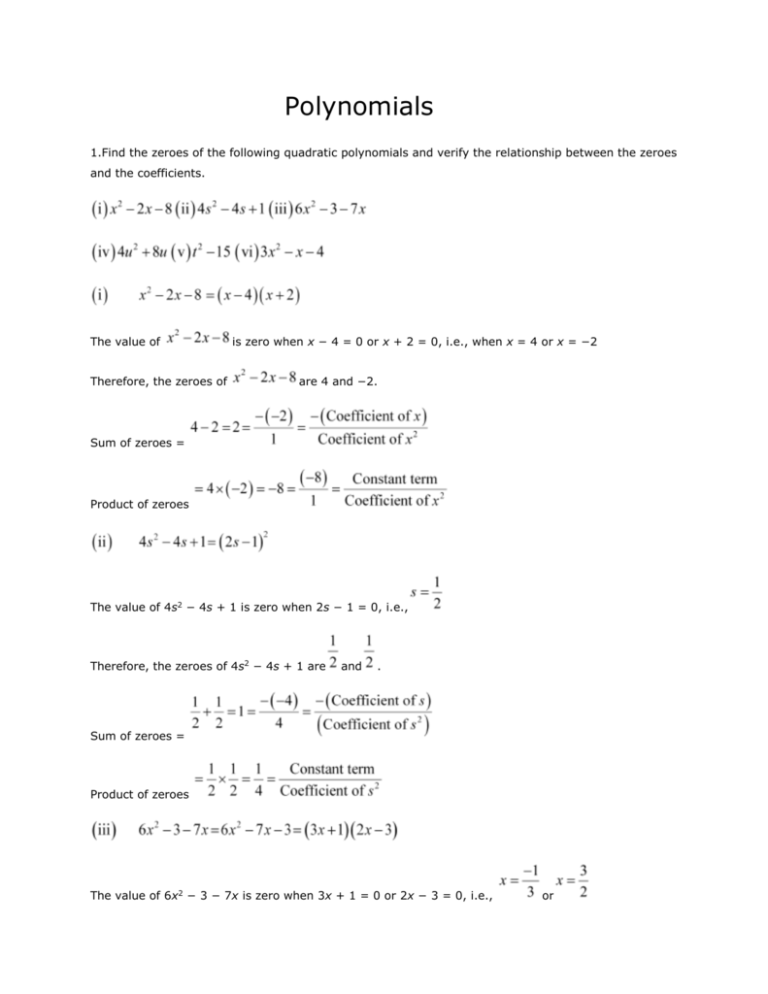
Polynomials 1.Find the zeroes of the following quadratic polynomials and verify the relationship between the zeroes and the coefficients. The value of Therefore, the zeroes of is zero when x − 4 = 0 or x + 2 = 0, i.e., when x = 4 or x = −2 are 4 and −2. Sum of zeroes = Product of zeroes The value of 4s2 − 4s + 1 is zero when 2s − 1 = 0, i.e., Therefore, the zeroes of 4s2 − 4s + 1 are and . Sum of zeroes = Product of zeroes The value of 6x2 − 3 − 7x is zero when 3x + 1 = 0 or 2x − 3 = 0, i.e., or Therefore, the zeroes of 6x2 − 3 − 7x are . Sum of zeroes = Product of zeroes = The value of 4u2 + 8u is zero when 4u = 0 or u + 2 = 0, i.e., u = 0 or u = −2 Therefore, the zeroes of 4u2 + 8u are 0 and −2. Sum of zeroes = Product of zeroes = The value of t2 − 15 is zero when Therefore, the zeroes of t2 − 15 are Sum of zeroes = Product of zeroes = or and , i.e., when . The value of 3x2 − x − 4 is zero when 3x − 4 = 0 or x + 1 = 0, i.e., when Therefore, the zeroes of 3x2 − x − 4 are or x = −1 and −1. Sum of zeroes = Product of zeroes 2. Find a quadratic polynomial each with the given numbers as the sum and product of its zeroes respectively. Let the polynomial be , and its zeroes be and . and . Therefore, the quadratic polynomial is 4x2 − x − 4. Let the polynomial be , and its zeroes be Therefore, the quadratic polynomial is 3x2 − Let the polynomial be x + 1. , and its zeroes be and . Therefore, the quadratic polynomial is 3. Check whether the first polynomial is a factor of the second polynomial by dividing the second polynomial by the first polynomial: = Since the remainder is 0, Hence, is a factor of . Since the remainder is 0, Hence, is a factor of Since the remainder Hence, . , is not a factor of . 4. Obtain all other zeroes of , if two of its zeroes are Since the two zeroes are , is a factor of Therefore, we divide the given polynomial by We factorize Therefore, its zero is given by x + 1 = 0 x = −1 . . . As it has the term , therefore, there will be 2 zeroes at x = −1. Hence, the zeroes of the given polynomial are , −1 and −1. 5. On dividing by a polynomial g(x), the quotient and remainder were x − 2 and − 2x + 4, respectively. Find g(x). g(x) = ? (Divisor) Quotient = (x − 2) Remainder = (− 2x + 4) Dividend = Divisor × Quotient + Remainder g(x) is the quotient when we divide by 6. Give examples of polynomial p(x), g(x), q(x) and r(x), which satisfy the division algorithm and (i) deg p(x) = deg q(x) (ii) deg q(x) = deg r(x) (iii) deg r(x) = 0 According to the division algorithm, if p(x) and g(x) are two polynomials with g(x) ≠ 0, then we can find polynomials q(x) and r(x) such that p(x) = g(x) × q(x) + r(x), where r(x) = 0 or degree of r(x) < degree of g(x) Degree of a polynomial is the highest power of the variable in the polynomial. (i) deg p(x) = deg q(x) Degree of quotient will be equal to degree of dividend when divisor is constant ( i.e., when any polynomial is divided by a constant). Let us assume the division of by 2. Here, p(x) = g(x) = 2 q(x) = and r(x) = 0 Degree of p(x) and q(x) is the same i.e., 2. Checking for division algorithm, p(x) = g(x) × q(x) + r(x) = 2( ) = Thus, the division algorithm is satisfied. (ii) deg q(x) = deg r(x) Let us assume the division of x3 + x by x2, Here, p(x) = x3 + x g(x) = x2 q(x) = x and r(x) = x Clearly, the degree of q(x) and r(x) is the same i.e., 1. Checking for division algorithm, p(x) = g(x) × q(x) + r(x) x3 + x = (x2 ) × x + x x3 + x = x3 + x Thus, the division algorithm is satisfied. (iii)deg r(x) = 0 Degree of remainder will be 0 when remainder comes to a constant. Let us assume the division of x3 + 1by x2. Here, p(x) = x3 + 1 g(x) = x2 q(x) = x and r(x) = 1 Clearly, the degree of r(x) is 0. Checking for division algorithm, p(x) = g(x) × q(x) + r(x) x3 + 1 = (x2 ) × x + 1 x3 + 1 = x3 + 1 Thus, the division algorithm is satisfied. 7. Verify that the numbers given alongside of the cubic polynomials below are their zeroes. Also verify the relationship between the zeroes and the coefficients in each case: (i) Therefore, , 1, and −2 are the zeroes of the given polynomial. Comparing the given polynomial with , we obtain a = 2, b = 1, c = −5, d = 2 Therefore, the relationship between the zeroes and the coefficients is verified. (ii) Therefore, 2, 1, 1 are the zeroes of the given polynomial. Comparing the given polynomial with , we obtain a = 1, b = −4, c = 5, d = −2. Verification of the relationship between zeroes and coefficient of the given polynomial Multiplication of zeroes taking two at a time = (2)(1) + (1)(1) + (2)(1) =2 + 1 + 2 = 5 Multiplication of zeroes = 2 × 1 × 1 = 2 Hence, the relationship between the zeroes and the coefficients is verified. 8. Find a cubic polynomial with the sum, sum of the product of its zeroes taken two at a time, and the product of its zeroes as 2, − 7, − 14 respectively. Let the polynomial be and the zeroes be It is given that If a = 1, then b = −2, c = −7, d = 14 Hence, the polynomial is . .
